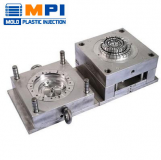Injection moulding is a process that has been used for many years to manufacture plastic parts. It involves melting plastic pellets and injecting the molten material into a mould where it cools and solidifies into the desired shape. One of the key components of this process is the gate point. This is where the molten plastic enters the mould cavity from the runner system. The gate point plays a crucial role in determining the quality and consistency of the final product.
From what they are, their importance in the manufacturing process, and common types of gate points used, to how choosing the right gate point can have significant advantages for your production line. Read on to learn more about this essential component of injection moulding.
Plastic Injection Molding: Gate Basics:
The gate plays a crucial role in plastic injection molding, as it is where the molten plastic enters the mold cavity. The design of the gate is critical to the quality and properties of the final product. Different types of gates have different benefits and drawbacks, such as edge, tunnel, submarine, or tab gates. Proper placement and sizing of gates are important to minimize defects in the finished product.
The gate vestige or mark should also be considered for aesthetic purposes since it may affect the appearance of the end product. Therefore, it’s essential to choose the appropriate gate design to ensure that it doesn’t leave any unsightly marks on your finished product. Understanding how to optimize gate placement and design can help you achieve better results in your plastic injection molding projects.
What is a Gate Point in Injection Moulding?
Injection molding is a popular manufacturing process that produces high-quality plastic products. The gate point plays an important role in this process. It is the location where the molten plastic enters the mold cavity. The size and location of the gate point can significantly impact the quality and strength of the final product.
Manufacturers use different types of gates, such as edge gates and hot runner gates, depending on their specific requirements. Proper placement of the gate point is crucial for achieving uniform filling and avoiding defects in the molded parts. Hence, understanding the importance of gate points in injection molding is vital for ensuring high-quality and flawless products.
Importance of Gate Point in Injection Moulding Process:
In injection moulding, the gate point is a critical factor in determining the flow of molten plastic into the mould. The size and location of the gate point can impact factors such as part strength, surface finish, and cycle time. Properly positioning the gate point can reduce waste and minimize production costs.
Choosing the right type of gate (edge, sprue, or hot runner) is also important in ensuring the quality of the final product. Edge gates are commonly used for small parts, while sprue gates are preferred for larger parts. Hot runner gates can provide faster cycle times and better control over temperature.
The importance of gate points in injection moulding cannot be overstated. A correctly positioned gate point can lead to high-quality products with minimal waste, which ultimately translates to greater efficiency and cost savings.
Common Types of Gate Point in Injection Moulding:
Gate points are crucial in injection molding as they determine the quality and functionality of the final product. There are several types of gate points used in injection molding, including sprue gates, pinpoint gates, edge gates, submarine gates, and fan gates. Sprue gates are the most common type and are located at the point where plastic enters the mold. Pinpoint gates are ideal for precision molding due to their small size. Edge gates are often used for large parts or when appearance is not a concern, as they are located on the edge of the part. Submarine gates are useful when gating needs to be hidden or when parts need to be attached to a runner system. Fan gates create a wide opening for plastic flow and are commonly used in thin-walled parts. Each type of gate point has its unique advantages and disadvantages, making it important to choose the right one based on your specific requirements.
Advantages of Choosing the Right Gate Point in Injection Moulding:
The gate point location in injection molding is an essential factor that affects the product quality, production efficiency, and waste reduction. Choosing the right gate point can optimize the filling pattern and flow rate of the molten plastic material. It can also lead to better mold cooling, which helps prevent warping or defects in the final product. Proper selection of gate point reduces cycle times, leading to increased production efficiency.
Moreover, selecting the right gate point position impacts the ease of removing the finished product from the mold. Therefore, proper consideration of gate point location leads to efficient production processes with high-quality products and reduced waste.
Conclusion of Point in Injection Moulding:
In conclusion, gate point location is a crucial factor in injection molding. It can impact the quality of the final product, production time, and cost. Choosing the right gate point can lead to better part quality, fewer defects, and reduced cycle times.
There are several types of gate points to choose from, and selecting the right one depends on a range of factors such as material type, product design, and production goals. To learn more about optimizing your injection molding process with an ideal gate point selection, contact our experts today for a consultation.
 Plastic Injection Mold Material Guide – Advantages & Applications Of 20 Common Injection Molding Materials
Plastic Injection Mold Material Guide – Advantages & Applications Of 20 Common Injection Molding Materials  10 Plastic Injection Processes – Advantages, Disadvantages, And Applications Of Plastic Injection
10 Plastic Injection Processes – Advantages, Disadvantages, And Applications Of Plastic Injection  Understanding the Importance of Injection Molding Pressure and Measuring Sensors
Understanding the Importance of Injection Molding Pressure and Measuring Sensors  Custom Plastic Mold Injection Molds: Revolutionizing Manufacturing Processes
Custom Plastic Mold Injection Molds: Revolutionizing Manufacturing Processes